JHP Newsletter - 2012, No. 1, 23 March
Greetings from Sellersville, Pennsylvania. I'm taking a short vacation to visit family and friends.
Web: New Look and New Images
The James Hager Photography website has an updated look and feel, and I'm particularly happy with the new online galleries with larger images. The work was done by Avanti Web House, a website development company aimed at small businesses.
I've also updated my Showcase Galleries with many new images, some of which have not been on the web before. Enjoy!
Travel: Bighorn Rut in Colorado
At the end of November 2011, we spent some time photographing the bighorn sheep during the rut in Clear Creek County, Colorado. We witnessed and photographed lots of head butting (below left) as the rams competed for the ewes. I was surprised to see three rams involved at the same time with two rams fighting against another, especially when they were only about 5 yds (5m) away. Fortunately, the rams weren't too concerned about hornless humans getting their girls. We also had lots of opportunities to take portrait images of the rams (below right).

1/500 sec, f5.6, ISO 500
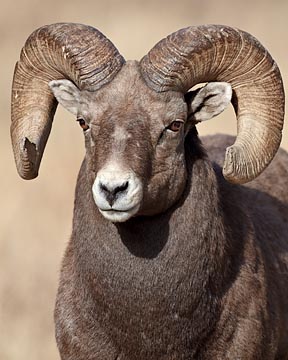
1/2000 sec, f5.6, ISO 400
Travel: White Sands National Monument
We spent a few days at White Sands National Monument in New Mexico in the middle of January. The light and clouds were fairly cooperative, and I was quite happy with the images I was able to make. At that time of the year, the gate to the park opens at 7:00 am and sunrise is about 7:05 — not very good for making images at, and especially before, sunrise. However, one morning I was able to go into the park as soon as the gates opened, drive a short distance in among the dunes, and then dash out into the dunes in time to capture some wonderful golden light on the dunes (below left). Another day, I concentrated on the cracks in the gypsum dunes (below right). The area had received a lot of rain in the preceding months, and the sand cracked as it dried out.
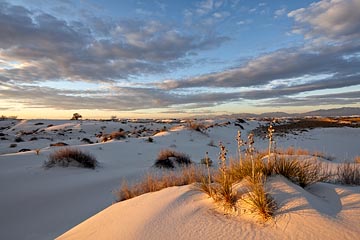
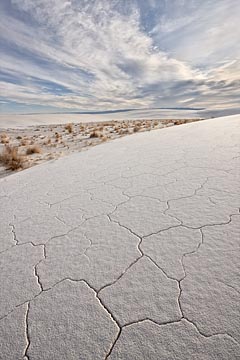
1/750, 1/350, and 1/180 sec; f8; ISO 100
Travel: Guadalupe Mountains National Park
Towards the end of January, we spent a few days in Guadalupe Mountains National Park. It was the first time that either of us had been to this park in extreme western Texas. I think there's some great potential for photography, but we were hindered by extremely strong winds that really reduced the amount of exploration and photography we were able to do. The clouds cooperated one evening and lit up nicely above the Guadalupe Mountains, but because we hadn't fully explored the boulder field in the foreground, I had to rush to find a nice composition (below left). The next evening, I returned to the same area and the clouds didn't cooperate. However, I was able to find a much more pleasing foreground, and the boulders reflected the light from the red clouds to the west (below right).
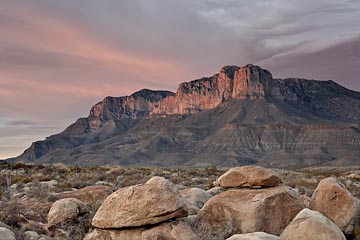
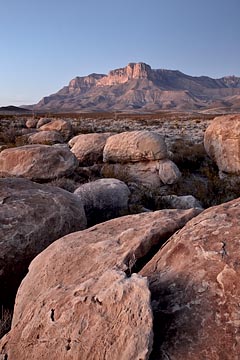
30 sec, f16, ISO 100
Travel: San Juan Basin, New Mexico
At the end of January and the Beginning of February, we explored a new area of the San Juan Basin in northwestern New Mexico. The Bisti Wilderness is a well-known part of the basin that we've visited before, and the whole basin has interesting badlands. There were fantastic clouds and blue sky one morning, and I used my 17mm Tilt/Shift lens to make the most of the sky (below left). I made three exposures to capture detail in the bright foreground, darker sky in the middle of the frame, and an even darker sky at the top of the frame. Then I combined them by hand in Photoshop. The previous day, the sky wasn't nearly as exciting, so I focussed on compositions that would eliminate or minimize the amount of sky. I found an incredible collection of petrified wood atop one of the ridges (below right), and the large chunk in the foreground has a clearly-visible knot, something I had never seen before.
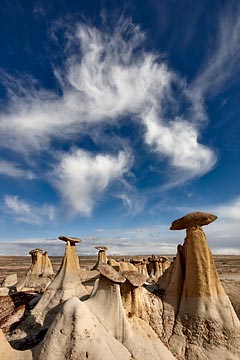
1/250, 1/180, and 1/125 sec; f11; ISO 100
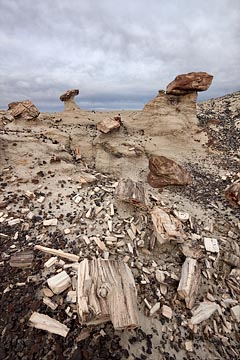
1/60 & 1/30 sec, f11, ISO 100
Travel: San Juan Mountains, Colorado
In mid February, we spent several days in the San Juan Mountains of southwestern Colorado in order to photograph landscapes with snow. The clouds didn't cooperate for the first few days, but then they started to break and I was able to capture one of my favorite images in this Newsletter, a group of aspens in early morning light against some dark clouds (below left). Three days later, conditions let me capture Mt. Sneffels shortly after sunrise with a fresh dusting of snow (below right).
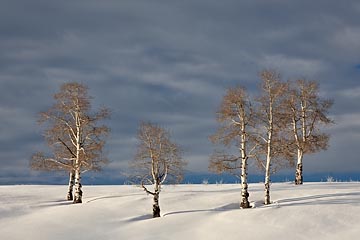
polarizer, 1/30 sec, f11, ISO 100
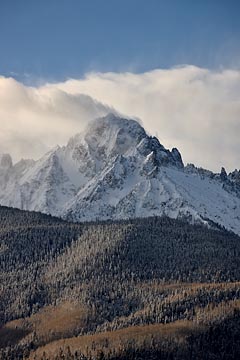
1/350 sec, f8, ISO 100
One afternoon, we visited the Ouray Ice Park which is located along a one mile stretch of the Uncompahgre Gorge near Box Cañon Falls. A system of pipes and nozzles are used to spray the sides of the gorge to create a wall of ice for ice climbers and in this case photographers (below left). Another afternoon, we photographed the snow pillows on the Dolores River. It had snowed heavily the day before and the trees were still covered with snow which gives the image a sense of freshness. The bright overcast helped bring out the texture in the snow without creating harsh shadows. It doesn't get much better than that for photographing a winter scene!
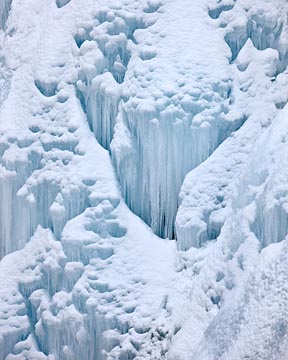
1/180 sec, f8, ISO 100
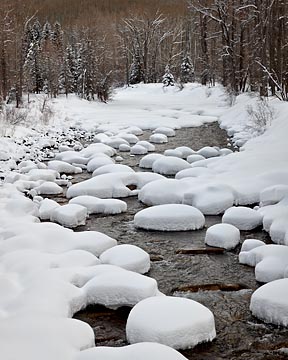
1/60 sec, f11, ISO 100
Travel: Southern Utah and Northern Arizona
Towards the end of February, we spent a few days in the southern part of Grand Staircase - Escalante National Monument in southern Utah and the Vermillion Cliffs National Monument in northern Arizona. One of the first places we photographed was the Toadstool Trail off US-89 in Grand Staircase - Escalante National Monument. The toadstools and hoodoos are easily accessible which mean that they're very popular. Too popular if you ask me because there were footprints all over the place from visitors when the ground was muddy. It was a real challenge to make an image where the footprints weren't an issue. Even in this image (below left), with very little ground included, I had to clone out some footprints. I used the shift motion of my 24mm Tilt/Shift lens to look up while keeping the camera back vertical so that the toadstool wouldn't look like it was falling over.
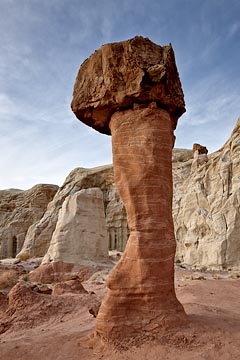
National Monument, Utah, USA
1/60 sec, f11, ISO 100
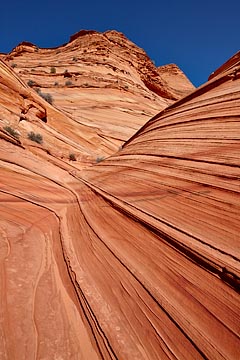
National Monument, Arizona, USA
1/250 & 1/180 sec, f11, ISO 100
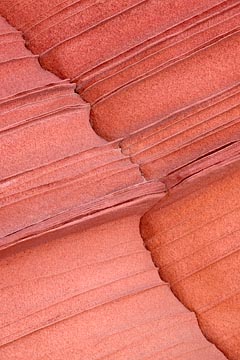
National Monument, Arizona, USA
(at 170mm), 1/10 sec, f11, ISO 100
We obtained a permit to visit the Coyote Buttes South section of Vermillion Cliffs National Monument for two days. You might be familiar with the Coyote Buttes North section which is where the world-famous "Wave" is located. The southern section has similar ridged sandstone formations, including what some call the "Mini Wave" (above center). There is something to photograph almost everywhere you look, including details of the sandstone (above right). Shortly after I made this image, I tore the lateral meniscus in my left knee — definitely not a technique I would recommend to improve your landscape photography! We had to cut our visit short so I could seek medical attention, but we'll be back when I can freely explore the area again.
Travel: Valley Of Fire State Park, Nevada
At the end of February and the beginning of March, we spent about two weeks at Valley Of Fire State Park in southern Nevada, not too far from Las Vegas. Some photographer friends of ours from Canada were there, and I was was able to get additional medical attention and some physical therapy in Las Vegas. It was our first time to the park, and I was quite frustrated to be stuck in the RV when we first arrived because my knee needed lots of rest. On the first day that I could hobble around without crutches, I went out into the heart of the park and photographed from the road not far from the car (below left). It was great therapy to get out among the beautiful scenery and do some photography.
As I became more mobile, I started exploring one area of the park that was easily accessible. I went further and further every day, and became quite familiar with the area. One morning when the clouds weren't interesting, I went to a small arch and photographed it before sunrise because I knew that the the wonderful warm diffuse light would illuminate the under side of the arch (below right). That's a big advantage of being familiar with an area — you know where to go to take advantage of the shooting conditions.
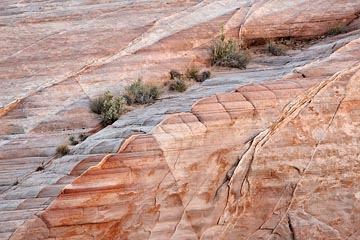
1/4 sec, f11, ISO 100
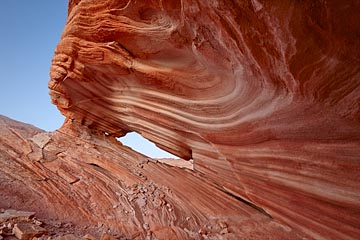
There are so many opportunities to photograph details in the sandstone because of the various colors and layers. I focussed on such images on one of my first forays away from the road (below left). I didn't really need to use my 24mm Tilt/Shift lens for this image, but it was the one I had with me (one travels light when you can barely walk to begin with) because I had envisioned other shots from the car.
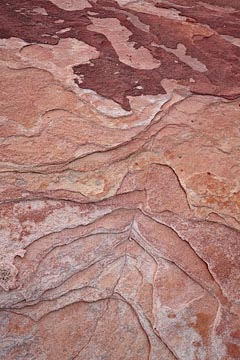
1/30 sec, f8, ISO 100
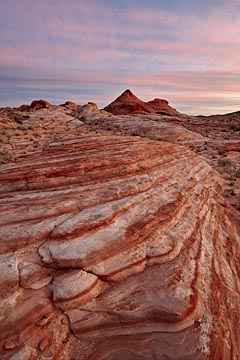
1/4 sec, f8, ISO 100
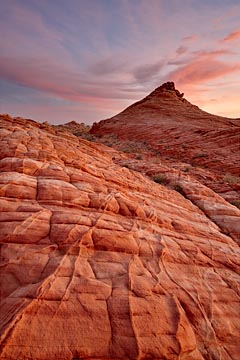
0.3 sec, f8, ISO 100
The clouds cooperated on two of the mornings I was out in my favorite area. In the image above center, I was drawn to the red and white layers of sandstone. In the image above right, I was finally able to justice to some of the small ridges that were scattered throughout the area. Our time at Valley Of Fire was too short, and we'll definitely return.
Take care and happy shooting.
— James
James Hager Photography :: www.jameshagerphoto.com




